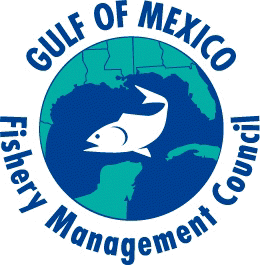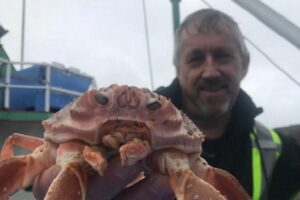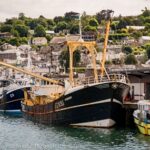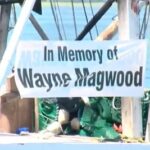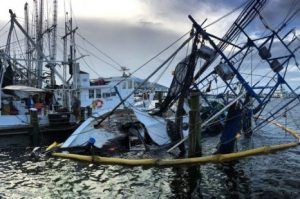Daily Archives: October 16, 2016
Essex Pinky Schooner Ardelle to be Showcased at The Boatshop at Strawbery Banke in Portsmouth, NH, Saturday, November 12
 The Boatshop at Strawbery Banke in Portsmouth, NH, will host “An Afternoon with ARDELLE: Harold Burnham and the building of an Essex Schooner” with Essex Shipbuilder and National Heritage Fellow Harold Burham and Photographer Dan Tobyne. This colorful, illustrated discussion about the building of the ARDELLE and the creation of The Shipwright and the Schooner, the newly released softcover book that chronicles the project, will take place on Saturday, November 12 at 4:00pm at the Strawbery Banke Museum Tyco Visitor Center. The presentation will conclude with a chance to mix and mingle with Burnham and Tobyne. Refreshments will be served. On September 6, 2010, facing the “economic downturn” head on with no prospects for work and slowly going broke, Burnham laid the keel for a 40-ton pinky schooner. Over the course of the vessel’s construction, his friends and family came through offering, time, materials, expertise, and money. In less than a year, the ARDELLE was completed, certified by the Coast Guard to carry 49 passengers, and now operates charter sails out of Gloucester. Read the rest and the details here 18:29
The Boatshop at Strawbery Banke in Portsmouth, NH, will host “An Afternoon with ARDELLE: Harold Burnham and the building of an Essex Schooner” with Essex Shipbuilder and National Heritage Fellow Harold Burham and Photographer Dan Tobyne. This colorful, illustrated discussion about the building of the ARDELLE and the creation of The Shipwright and the Schooner, the newly released softcover book that chronicles the project, will take place on Saturday, November 12 at 4:00pm at the Strawbery Banke Museum Tyco Visitor Center. The presentation will conclude with a chance to mix and mingle with Burnham and Tobyne. Refreshments will be served. On September 6, 2010, facing the “economic downturn” head on with no prospects for work and slowly going broke, Burnham laid the keel for a 40-ton pinky schooner. Over the course of the vessel’s construction, his friends and family came through offering, time, materials, expertise, and money. In less than a year, the ARDELLE was completed, certified by the Coast Guard to carry 49 passengers, and now operates charter sails out of Gloucester. Read the rest and the details here 18:29
Gulf of Mexico Fishery Management Council meeting in Biloxi, MS, October 17 – 21, 2016
Voices of Alaska: Future of wild salmon depends on decisions made today, by Commercial Fisherman Steve Harrison
 Our state is home to the nation’s last stronghold of wild salmon and, for the most part, we have managed our fisheries well. For generations Alaskans have sustainably harvested millions of wild salmon while this amazing fish continues to return to their native streams, spawn and rejuvenate the population every year. Tasked with developing policies that protect our salmon resource, the Alaska Board of Fish uses the basic principles of sustainable yield and conservative management to drive decision-making and, by-and-large, it has worked. But managing the harvest of salmon is only part of the equation. Ensuring our salmon runs remain strong also means protecting the habitat they depend on, from the wetlands at the headwaters of the streams they spawn all the way to the ocean where they spend the majority of their lives. In recent years, pressure to allow mining and damming interests to set up shop in and around our prolific salmon streams has increased greatly, with proposed projects like the Pebble Mine, Susitna dam, and the Chuitna Coal strip mine leading the charge. Read the rest here 17:15
Our state is home to the nation’s last stronghold of wild salmon and, for the most part, we have managed our fisheries well. For generations Alaskans have sustainably harvested millions of wild salmon while this amazing fish continues to return to their native streams, spawn and rejuvenate the population every year. Tasked with developing policies that protect our salmon resource, the Alaska Board of Fish uses the basic principles of sustainable yield and conservative management to drive decision-making and, by-and-large, it has worked. But managing the harvest of salmon is only part of the equation. Ensuring our salmon runs remain strong also means protecting the habitat they depend on, from the wetlands at the headwaters of the streams they spawn all the way to the ocean where they spend the majority of their lives. In recent years, pressure to allow mining and damming interests to set up shop in and around our prolific salmon streams has increased greatly, with proposed projects like the Pebble Mine, Susitna dam, and the Chuitna Coal strip mine leading the charge. Read the rest here 17:15
Fishermen in the North look forward to leaving EU
 In Portavogie on the Ards peninsula a new flag is flying proudly among the British union and Red Hand of Ulster flags fluttering from the lamp posts in this overwhelmingly unionist and loyalist fishing village in Co Down. It’s the “Fishing for Leave” ensign hoisted on the masts of many of the 40 or so trawlers that berth in this harbor. This is staunchly Brexit territory. Sitting on a bollard beside his trawler, the Golden Emblem, Harold Young says he doesn’t know of one fisherman who voted Remain in the referendum on whether or not the UK should stay in the European Union. Because of EU regulations and quotas he is mainly restricted to fishing for Dublin Bay prawns – more technically termed nephrops and also called the Norway lobster – and now believes there is a chance he will be able to catch whatever the sea offers up. Some years ago he was fined £20,000 (€22,000) for breaching a whitefish quota he had at the time, so the decision to get away from the bureaucracy of Brussels gladdens him. “Like the farmer, the fisherman should be able to land whatever is in season,” he says. Read the rest here 13:34
In Portavogie on the Ards peninsula a new flag is flying proudly among the British union and Red Hand of Ulster flags fluttering from the lamp posts in this overwhelmingly unionist and loyalist fishing village in Co Down. It’s the “Fishing for Leave” ensign hoisted on the masts of many of the 40 or so trawlers that berth in this harbor. This is staunchly Brexit territory. Sitting on a bollard beside his trawler, the Golden Emblem, Harold Young says he doesn’t know of one fisherman who voted Remain in the referendum on whether or not the UK should stay in the European Union. Because of EU regulations and quotas he is mainly restricted to fishing for Dublin Bay prawns – more technically termed nephrops and also called the Norway lobster – and now believes there is a chance he will be able to catch whatever the sea offers up. Some years ago he was fined £20,000 (€22,000) for breaching a whitefish quota he had at the time, so the decision to get away from the bureaucracy of Brussels gladdens him. “Like the farmer, the fisherman should be able to land whatever is in season,” he says. Read the rest here 13:34

Restoring history – 36-foot U.S. Coast Guard Motor Lifeboat CG36391
When Glen Cathers’ wife Naomi asked him what he would choose if he could have anything in the world, he replied, “I want a motor lifeboat.” “Let’s do it,” she said. A month later, they found CG36391 in Astoria, a 36-foot lifeboat built in 1934. It was “in major disrepair,” hardly recognizable. “I could see that bull nose on it, I knew right then what it was. It was the real deal.” They purchased it and began what would become a seven-year process of restoration. “It’s new from the waterline up,” he said of the boat as it floated tied up to the visitor dock at The Dalles Marina. It contains parts from 11 different boats. “Piece by piece, I collected all the parts we needed,” he said. The restoration was completed in 2012. Today the boat looks as it did in 1939. “A little more varnish maybe,” Cathers chuckled. “That was the first thing the crews did, get rid of the varnish.” Read the story here 11:46

This lobsterman’s boat was sunk 3 times in 7 weeks. He says he knows who did it.
Tony Hooper, who has lobstered out of area harbors on and off for years, says he knows who sank his 35-foot lobster boat, Liberty, three times in seven weeks: a fellow fisherman operating out of Port Clyde, one of three villages that constitute this peninsular town that extends 15 miles south of Rockland. The fisherman, Hooper alleges, turned a routine dispute over the placement of lobster traps into an ongoing drama that’s turned heads up and down the Maine coast. “The guy has a personal grudge against me, and I don’t know why, because I’ve never done anything to the guy,” Hooper says. “He’s just a young, arrogant kid who didn’t like it when I called him out for messing with my traps.” Boat sinkings are rare in the Maine lobster fishing community, but when they occur they often result from disputes between lobstermen from different harbors over fishing turf. But sinking the same lobsterman’s boat three times in quick succession – once on the very night it was repaired and put back on its mooring – is extremely rare. Read the story here 09:48

Interesting Interview with Fisherman/UFC veteran Cody “AK Kid” McKenzie
Can you run down some of work you’ve done outside MMA? I’ve had lots of jobs, I’ve roofed, I’ve fished, cut wood, I can’t think of all the jobs I’ve done. I actually used to have a car washing business when I was really young. I grew up around gill netters, gill netting for salmon, for red, sockeyes, all different kinds of salmon, and then I also seine for salmon, which is just a different type of fishing, and then last year, after the seine season, I went up to the Bering Sea and did king crab out there. That’s the one everyone watches on The Deadliest Catch. It was good work, it was hard work, long hours, but I enjoyed it a lot. I really like fishing. A lot of people in the fight game try to insult me, saying ‘Go back fishing, you’re not a fighter,’ and I just get a good laugh, because it’s like, yeah I enjoy fishing, it’s good hard work, I wasn’t born with a silver spoon, I worked for a living, and nowadays some of these MMA fighters think that’s a bad thing. It’s kinda become a rich kids’ sport where you need twelve coaches and a nutritionist, it’s a different sport from when I got into it for sure, but to each their own. Read the interview here 09:16






